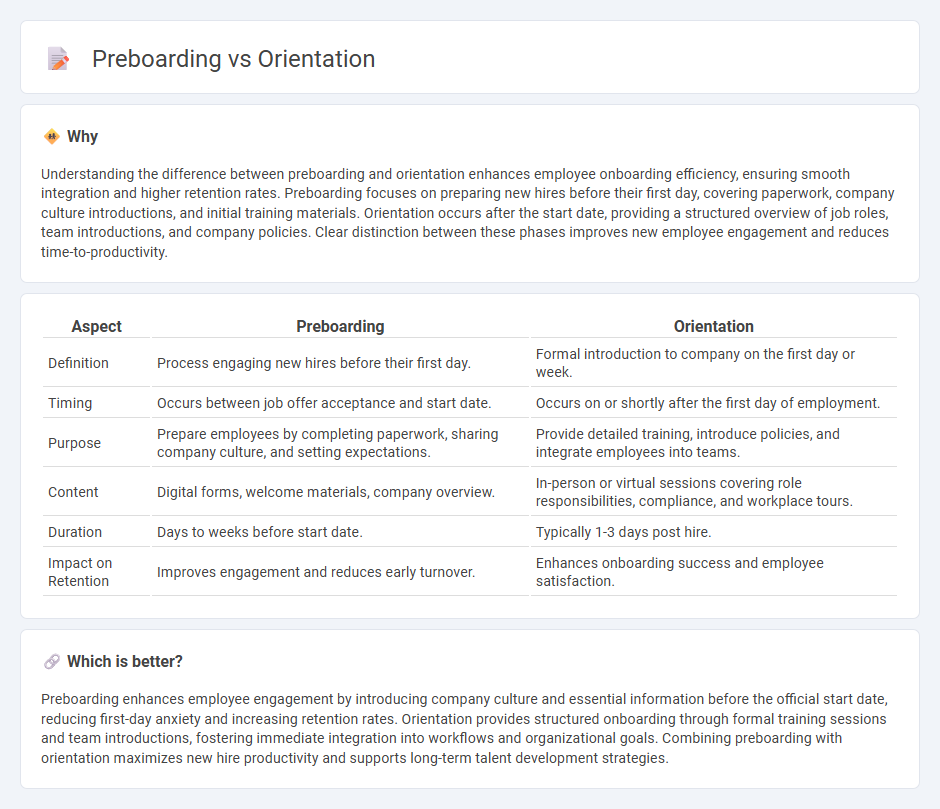
Preboarding begins immediately after a candidate accepts a job offer, focusing on administrative tasks, document submission, and early engagement activities to prepare new hires for their first day. Orientation typically occurs on or just before the first day, providing essential company information, culture introduction, and role-specific training to integrate employees into the organization. Discover more about optimizing human resources processes for effective employee onboarding and retention.
Why it is important
Understanding the difference between preboarding and orientation enhances employee onboarding efficiency, ensuring smooth integration and higher retention rates. Preboarding focuses on preparing new hires before their first day, covering paperwork, company culture introductions, and initial training materials. Orientation occurs after the start date, providing a structured overview of job roles, team introductions, and company policies. Clear distinction between these phases improves new employee engagement and reduces time-to-productivity.
Comparison Table
| Aspect | Preboarding | Orientation |
|---|---|---|
| Definition | Process engaging new hires before their first day. | Formal introduction to company on the first day or week. |
| Timing | Occurs between job offer acceptance and start date. | Occurs on or shortly after the first day of employment. |
| Purpose | Prepare employees by completing paperwork, sharing company culture, and setting expectations. | Provide detailed training, introduce policies, and integrate employees into teams. |
| Content | Digital forms, welcome materials, company overview. | In-person or virtual sessions covering role responsibilities, compliance, and workplace tours. |
| Duration | Days to weeks before start date. | Typically 1-3 days post hire. |
| Impact on Retention | Improves engagement and reduces early turnover. | Enhances onboarding success and employee satisfaction. |
Which is better?
Preboarding enhances employee engagement by introducing company culture and essential information before the official start date, reducing first-day anxiety and increasing retention rates. Orientation provides structured onboarding through formal training sessions and team introductions, fostering immediate integration into workflows and organizational goals. Combining preboarding with orientation maximizes new hire productivity and supports long-term talent development strategies.
Connection
Preboarding sets the foundation by familiarizing new hires with company culture, policies, and job expectations before their official start date, enhancing employee engagement and reducing first-day anxiety. Orientation builds on this by providing hands-on training, introducing team members, and clarifying role-specific responsibilities to ensure a smooth transition into the workplace. Together, preboarding and orientation improve retention rates and accelerate new employee productivity through structured integration processes.
Key Terms
Onboarding
Orientation introduces new hires to company culture, policies, and expectations, serving as a foundational step in employee integration. Preboarding occurs between the job acceptance and first day, covering paperwork, technology setup, and initial introductions to streamline the onboarding process. Discover effective strategies to optimize each stage of onboarding for improved employee engagement and retention.
Company Culture
Orientation introduces new employees to company culture by highlighting core values, mission, and expected behaviors through structured sessions and interactive activities. Preboarding begins before the first day, offering early exposure to cultural elements via digital resources, welcome messages, and preliminary engagement to foster a sense of belonging. Discover effective strategies to seamlessly embed company culture from preboarding to orientation for enhanced employee integration.
Compliance
Orientation focuses on ensuring new hires understand company policies, legal requirements, and compliance standards through structured sessions that cover workplace regulations and ethical guidelines. Preboarding begins immediately after hiring, preparing employees by providing essential documents, training materials, and compliance checklists to streamline the transition and ensure adherence from day one. Discover how optimizing both processes enhances regulatory compliance and employee readiness effectively.
Source and External Links
Orientation - Wikipedia - Orientation broadly refers to the direction or position of an object in space, mental awareness of time, place and person, or preferences such as sexual or romantic inclination, as well as introductory training for newcomers in institutions.
Orientation (mental) - Wikipedia - Mental orientation involves awareness of three dimensions: time, place, and person, with disorientation indicating problems in this cognitive function often due to physiological or psychological causes.
ORIENTATION | definition in the Cambridge English Dictionary - Orientation can mean a person's preferences or aims, sexual or romantic attraction, the focus of an organization, or the process of training/introducing someone to a new job or activity.
 dowidth.com
dowidth.com